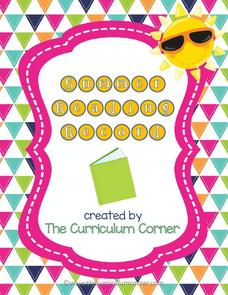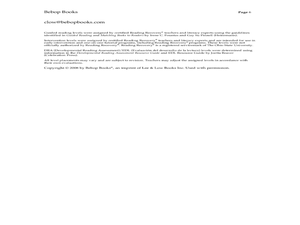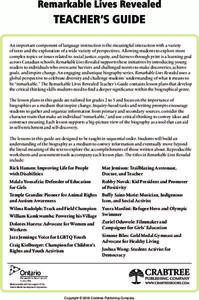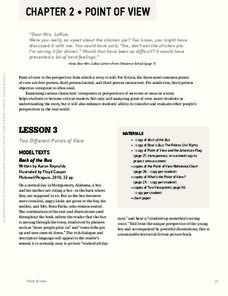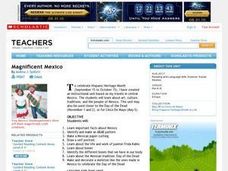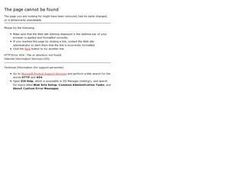Curated OER
Distinguishing Fiction and Non Fiction
Have your class go on picture walks of different books, and identify them as either fiction or non fiction and why. Working in groups, kindergartners state whether the book tells information or comes from the author's imagination. Use...
Curriculum Corner
Summer Reading Record
No more summer reading lag! Give young readers a set of graphic organizers and worksheets to keep track of the books they read over the summer and to keep reading comprehension skills fresh. The graphic organizers include identifying...
PBS
Reading Adventure Pack: Building
Scholars become architects in an engaging unit on building structures. The Reading Adventure Pack features Roberto: The Insect Architect by Nina Laden and Construction Zone with photographs by Richard Sobol and text by Cheryl Willis...
Curated OER
Pumpkins
Observe the differences between the inside and outside of a pumpkin. Learners discuss what pumpkins are used for and then view a pumpkin. Next, they view the inside of the pumpkin and draw the differences they see.
Curated OER
How-To Books
Students apply their knowledge and create a how-to book of their own. In this early childhood language arts worksheet, students learn about non-fiction books and write their own procedural non-fiction booklets.
Curated OER
Digging Up Dinosaurs
In this dinosaurs worksheet, students read a nonfiction book about dinosaurs and then answer 6 comprehension questions and present an oral presentation.
Curated OER
The Tale of Peter Rabbit
Students read The Tale of Peter Rabbit and make predictions through a picture walk before they read. In this reading lesson plan, students also color the pages of the booklet and put it in the correct order.
Curated OER
Guided Reading: Shapes Where We Play
Students discover shapes on a playground. In this guided reading lesson, students discover new vocabulary words related to shapes as they read Shapes Where We Play. In small groups, students use picture clues and one to one matching to...
Curated OER
Under the Sea - KWL Chart
Students create a KWL chart to start the discussion on ocean animals. They practice sorting the animals into their different classifications. They use indexes, table of contents and glossary to find information.
Crabtree Publishing
Remarkable Lives Revealed
Six lessons make up a unit all about biographies. Scholars read about a remarkable life while taking notes and identifying characteristics of the biographical genre. Readers examine the tale's obstacles, accomplishments, and sequence of...
Novelinks
Tuesdays with Morrie: K-W-H-L Strategy
Readers of Tuesdays with Morrie are directed to use a K-W-H-L chart to record what they know, what they want to learn, how they will find information, and what they learned about a particular topic related to Mitch Albom's book.
Curated OER
Drawing Birds
First graders discuss what they know about birds and share picture books. They read text on the page and discuss the question and draw the flying bird on their paper by having them look at the color drawing of the bird.
Curated OER
Introduce: Comparison and Contrast
Class discussions can really make concepts come to life. The class discusses the differences between compare and contrast, read a book, then talk about ways they can compare events or characters in the story. Good leading question are...
Curated OER
Where Do We Begin?
Primary learners grasp sequence of events by discussing morning routines and reviewing the story of Little Red Riding Hood. They explore the necessity of correct order of events. As a class, create a story with a beginning, middle, and...
Scholastic
Point of View
The point of view in a story can dramatically change the story itself. Focus on finding the points of view in various reading passages with a language arts packet, which includes fiction and nonfiction text.
Museum of Disability
Buddy, The First Seeing Eye Dog
Learn about how the seeing eye dog program began with a reading lesson about Eva Moore's chapter book, Buddy, The First Seeing Eye Dog. With vocabulary words, discussion questions, and extension resources, the lesson is a great way for...
Curated OER
Social Studies Review Third Grade
In this review of various skills instructional activity, students answer multiple choice questions about Georgia history, references, fiction and nonfiction, and U.S. history. Students answer 12 questions.
Curated OER
Story Scrapbook
Pupils develop a comparison worksheet using one non fiction book and one fiction book they have read to be put into a class scrapbook. In their comparison students must have title, author, point of view, setting, characters, and other...
Curated OER
The Great Big Especially Beautiful Easter Egg
Young scholars make predictions about the book The Great Big Especially Beautiful Easter Egg by doing a picture walk. In this comprehension lesson plan, students read the book, see if their predictions were right, and draw pictures of...
Curated OER
Magnificent Mexico
Students complete a variety of activities in a unit about the art, culture, and traditions of Mexico. They read books about the Day of the Dead, create a skeleton puppet, and create a traditional Mexican tissue paper cutting. Students...
Curated OER
Analyzing Short Biographies to Discover Characteristics of Biographical Writing
Students read short biographies on Abraham Lincoln from various artists. Using the texts, they identify the subject of the biography and discuss whether or not illustrations contribute to a biography. They research specific information...
Curated OER
Native Americans
First graders explore the lifestyles of several North American tribes. They investigate about the homes, food, transportation, and daily living habits of each tribe. Pupils use a map to locate several Native American tribes in North...
Curated OER
Guided Reading With Fish Print
Students investigate the concept of reading comprehension using Fish Print. They practice reading skills with using picture clues, using context clues, and sight word recognition for simple sentences. The teacher guides the lesson with...
Curated OER
My Family
Young scholars read a story entitled, "My Family." They predict what they expect to they family will be doing in the book. Students explore strategies for decoding unfamiliar words. They brainstorm things family members might teach each...



